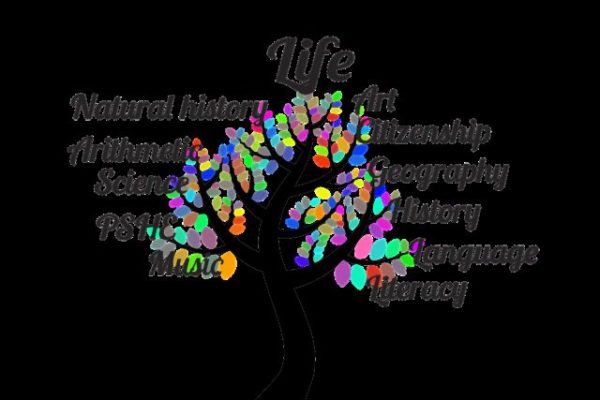In recent years, a lot of emphasis has been placed on the science of education. Focus on STEM classes and careers, data-driven decision making, and bachelor of science degrees awarded to newly-minted educators have all contributed to this. As current students, it might be hard for many of you to realize that this wasn’t always the case. If you are in a school that emphasizes STEAM or STREAM instead of STEM, you know that the arts, such as studio art and music, and the humanities, such as reading and/or religion, still have an important role to play in your education, and I’m sure it won’t surprise you to know that I am someone who believes that finding the right balance between the science and art of education is what is ultimately best for students. You may feel you are more of a science person or more of an art person, and you may choose your elective courses, extracurricular activities, postsecondary education and eventual career accordingly. No matter how far to one side of the academic spectrum you lean and how that might influence the choices you make, though, try to be willing to give the other side of both your studies and life itself a real chance. That way, you will be a more well-rounded student, as well as a more well-rounded person.
Long ago, the humanities, along with basic arithmetic, were the main focus of education, and a bachelor of arts degree was by far the most common education degree for new teachers. You may have heard of the three “R”s – reading, ‘riting, and ‘rithmetic – and wondered how that could possibly have been considered to be enough education for anyone. If you’ve also heard that college enrollment was much less common then than it is now, and you consider just how much education at all levels has been impacted by recent advances in science and technology, the shift in the focus of education, as well as the overall need for more education, should make sense. The idea for STEM education grew out of the realization that more students needed to be prepared for the advances being made in those fields, so that the ones who were meant to be the innovators of continued advances would be ready to meet their moment. Though it appeared at first that the emphasis being placed on STEM would necessarily crowd out the arts and humanities, more and more schools in recent years have chosen to emphasize STEAM or STREAM, thereby acknowledging that no matter how important to education the STEM fields have become, something important in a very different way is lost if STEM is all that matters.
Though many proponents of STEM education believe that every student should take as many STEM classes as they possibly can, the more challenging the better, the level of difficulty of these courses often keeps students from pursuing them or sticking with them. Even students who think they may be interested enough in these subjects to consider pursuing a career in one of them sometimes struggle to stick with it. If you find yourself in this situation, particularly if you have learning challenges that are contributing to your struggles, changing your mind and pursuing a different interest is understandable, allowable, and acceptable, especially once you are in college and can change your major. If, however, you are still in high school and your STEM classes are required, or you are in electives and/or more advanced classes because you are passionate about STEM and still wish to pursue it, don’t forget that applying study skills, asking for help, and choosing different courses or levels of courses are all ways you can improve your grades in STEM classes, whether you are passionate about them or not. If you believe your future is in STEM, applying study skills to it will help you get the most out of it, which will in turn keep your dreams for the future alive.
If you are more of an arts and humanities person, you, too, should choose electives, extracurricular activities and possible career paths accordingly, but that does not mean that you should discount the importance of the STEM fields to both your current education and your future endeavors. If required STEM classes are challenging for you, be sure to apply study skills to them and seek help in them as you need it. If your main issue with them is that you just don’t like them, try as you complete your work in them to find something about them you do like, because that will go a long way toward motivating you to increase your effort, improve your grades, and, ultimately, to see that these subjects do have value. Though I did not like lab work or the complicated math involved in advanced science courses, I still managed to put forth my best effort and get as much out of them as I possibly could by focusing on the new information and concepts I was learning, because expanding my knowledge base both played to my strengths and interested me. For you, it might be different, or even quite the opposite, but focusing on whatever you like best about science or any of the STEM classes will encourage you to see that they do have a place in your life. Recognizing that you do need STEM does not mean you need to reduce your focus on the arts and humanities, though that is something that it has unfortunately become more common in recent years for many educators and parents to say. There are ways in which the arts and humanities complement STEM and vice versa, such as the connection between math and music and the importance of written communication and publishing to scientific research. Technological advances have contributed greatly to artistic endeavors, too, and becoming familiar with how you can enhance your artistic experience through the use of technology might well lead you down unexpected future paths. Wherever your passions and talents lead you, and however much you embrace the part the STEM fields might play in your career, try not to lose sight of what the arts and/or humanities mean to you, or let anyone tell you that they have no place in your future. If they mean that much to you, they will have the place you make for them, whether you decide to combine them with STEM in some way or not.
Though education once was mainly an art, and now is much more a science, both views of it have their place, and both types of courses are still valuable to a well-rounded education. Finding something you like about each and every course you take, even if you are aware that it is not where your strength or passion lies, is a great way to motivate yourself to do your best, which makes it a great way to develop your study skills. Whether your school emphasizes STEM, STEAM, or STREAM, finding where you fit and making both present course and activity choices and future school and career choices to back that up, while recognizing that the different areas of study complement each other and may well lead you down some unexpected paths, will give you the best opportunity for success.

